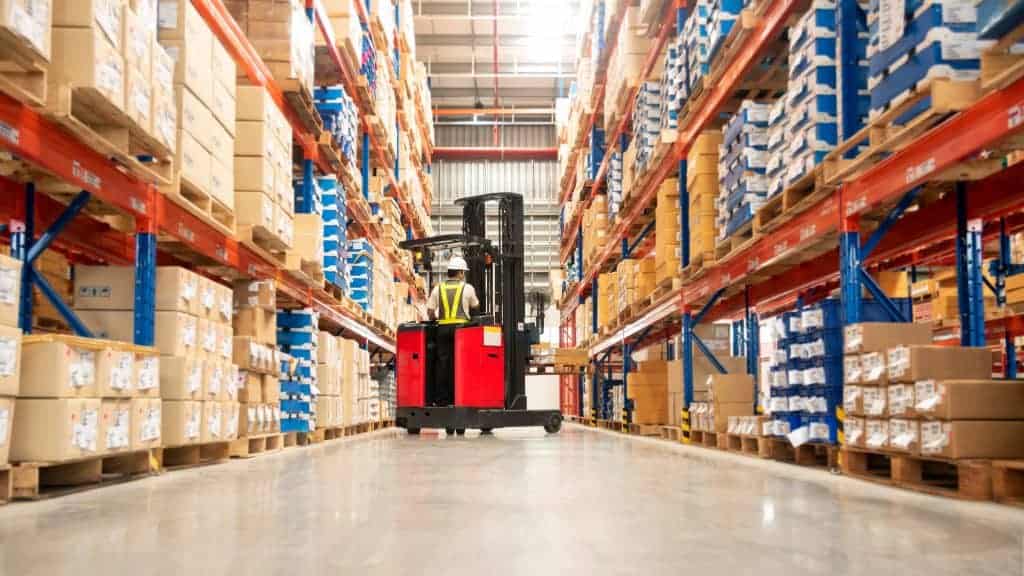Fulfillment Center Vs. Warehouse
The words “fulfillment center” are often used interchangeably with the word “warehouse“. The terms are similar but they hold different meanings. Both an ecommerce warehouse and ecommerce fulfillment center can hold inventory for your business but the services provided by each one are unique. Review our breakdown so that you can determine which is the best ecommerce option for your business.

This article will cover:
- What is an ecommerce fulfillment center?
- What is the difference between a warehouse vs. fulfillment center?
- How do fulfillment centers operate?
- What are the benefits of a fulfillment center?
What is an ecommerce fulfillment center?
Similar to a warehouse, an ecommerce fulfillment center (often referred to as a 3PL provider) also uses a building to store products ready for online sale but offers the additional service of order fulfillment. An ecommerce fulfillment center will work with retailers, e-commerce companies, and corporations to pick, pack, and ship both individual B2B and B2C orders.
The main purpose of a fulfillment center is to relieve online retailers of shipping online orders to their online buyers in a quick and efficient manner.
How do fulfillment centers operate?
Ecommerce businesses can outsource their order fulfillment to fulfillment centers who will assume the responsibility of shipping customer orders. Inventory is delivered to the fulfillment center where it is strategically stored in preparation for fulfilling customer’s online orders. Once an online customer makes a purchase on your ecommerce store, the fulfillment center will receive a pick sheet prompting the warehouse staff to pick, pack, label and ship the order. Fulfillment centers negotiate rates for pickup and delivery with shipping carriers like UPS, USPS, Fedex, and DHL.
In addition to the business-to-consumer (B2C) orders, fulfillment centers can handle business-to-business (B2B) orders that are sent to big-box retailers and individual shops. Fulfillment centers can also handle the complexities of EDI labeling requirements required by some big-box retailers.
Ecommerce businesses choose to outsource their ecommerce order fulfillment to 3PLs because it frees up the seller’s time to focus on improving customer service, managing inventory or other more strategic parts of the business.
What is a warehouse?
A warehouse is a building used for storing raw materials or manufactured goods before their export or distribution for sale. Warehouses are used by manufacturers, importers, wholesales, transport businesses and retailers. The term “ecommerce warehouse” is a warehouse that specific houses good that will be sold online. A warehouse is often used for longer storage periods with items stored in bulk.
What are the differences between warehousing and fulfillment centers?
- Short Term Storage vs. Long Term Storage
Fulfillment centers can act in a similar capacity to a warehouse but a warehouse is not a fulfillment center.
Typically items will be stored in a warehouse for a longer period of time when compared to a fulfillment center. The ecommerce fulfillment center’s goal is to get the products to customers who have placed orders out quickly as possible.
Fulfillment centers do warehouse inventory for short periods but with the expectation that the inventory will be turned rather quickly as orders are consistently being shipped. In an ideal world, the inventory would turnover in less than a month to prevent the seller from paying storage costs or warehousing fees. Sellers should watch their inventory levels and make sure to have enough product at their fulfilment center to keep customers happy and prevent backorders.
- Operations
An ecommerce fulfillment center is more active than a static warehouse and has a more complex operation. They will receive inventory, handle incoming online orders, pick the products from the shelves, pack them into boxes and prepare shipping labels. An ecommerce fulfillment center may also handle returns as well as kitting and assembly projects.
3PLs can provide these additional services:
- Receive inventory
- Generate pick lists and picking products
- Kitting and Assembly
- Packing boxes
- Labeling shipments
- Shipping orders
- Managing returns
- Shipping Carriers
Fulfillment centers tend to have strong relationships with multiple shipping carriers. As the orders come in, the labeled packages ready for shipping are sorted by carrier. The fulfillment company schedules a regular daily pickup time with each carrier. Domestic and international shipments will be collected by the shipping carriers to be taken to their sorting center in which packages are sorted by service type.
Same-day and/or next day shipments typically have an earlier order cutoff time because the carrier must schedule an earlier pickup time with the fulfillment center.
On the other hand, a warehouse will typically have less frequent pickups. The inventory is usually stored in bulk on pallets that may require an LTL or FTL scheduled pickup.
Does your ecommerce businesses need a fulfillment center or a warehouse?
What are the main advantages online sellers benefit from when using a fulfillment company?
If you no longer want to pack boxes and hurry to the post office every day with a car full of packages, then outsourcing your fulfillment can be a great solution. When you start to have issues handling your increasing order volume, it’s time to look at a 3PL. Ecommerce fulfillment centers are an ideal option for business owners that do not have the time or the capacity to store, pick, pack, and ship their own orders.
Benefits of using a fulfillment center:
- Not required to manage a physical space
- Not required to manage warehouse staff
- Not required to store inventory or packing boxes
- Lower overhead costs
- Tap into the expertise of logistics experts
- Lower shipping rates from carriers with 3PL rates
- More time to grow your business and focus on other aspects of your business
Outsourcing your ecommerce fulfillment to a 3PL means that the fulfillment center will take over responsibility for the fulfillment process and ensure your products are shipping in a timely manner. The 3PL can handle inventory management and negotiate the best shipping rate with carriers based on their volume. The time can be more strategically used to focus on marketing your product, improving your customer service, developing new products, or other areas to grow your business.
Automation technology in Modern Fulfillment Companies
Modern fulfillment companies keep technology at the center of their fulfillment services. This means that every step of the fulfillment process is automatically documented in real-time for ecommerce businesses to know the status of their inventory and each order in the fulfillment center without having to be there.
This is possible when fulfillment solutions have built-in integrations with ecommerce platforms and marketplaces. This connection enables each customer order to be automatically sent to fulfillment center to get picked, packed, and shipped out. Once shipped, tracking info is pushed back to the ecommerce store and shared with the customer.
How do fulfillment centers handle inventory management?
Your selected fulfillment center will receive your inventory and assign the inventory to a location in the fulfillment center. The inventory is assigned to a bin, shelf or pallet location and managed in warehouse management system (WMS). The WMS allows it’s users to track inventory as well as track lot numbers. Being able to see what’s going on inside of your fulfilment center and using tools to know when to reorder new stock will help prevent backorders.

warehouse worker and her female coworker talking while preparing shipment in a warehouse.
How much storage space will I need?
When planning for storage space, you’ll have to think about a number of factors. Fro instance, the number of unique SKUs you carry will affect the amount of storage space needed. For example, an ecommerce store selling shoes will need a specified storage location for each size and color.
The second thing to think about is your order volume. If you’re shipping hundreds to several thousands of orders every month, you need to plan space for inventory to fulfill current and future orders. You’ll also want to have enough stock to prevent backorders.
Warehouse space can drive costs up as rents are on the rise. Within a fulfillment center, the storage space is shared amongst multiple ecommerce businesses.
I’ve already promised my customers 1-2 day delivery, how can I make that possible with a fulfillment center?
Fulfillment centers are used to competing with Amazon’s 2 day shipping offer. Many fulfillment centers offer expedited delivery options with shipping carriers for 1-2 day delivery. The specific service and price will depend on the location of the fulfillment center and the location of the end customer. Some ecommerce clients will spread their inventory across a 3PLs multiple fulfillment centers.
How does order processing work?
A customer will place an order on your online store which is connected to the fulfillment center’s order management system via API integration. The order details will print on a pick sheet in the warehouse alerting the staff that the order needs to be picked off the shelf, put into a box with a shipping label and sorted for the carrier’s pickup. The shipping label will have a tracking number which is pushed back to the fulfillment order management system and the ecommerce platform of your online store.
How much should I pay for a good fulfillment solution?
If you plan to self-fulfill customer orders, plan for these costs:
- Warehouse Space Lease / Rent / Purchase
- Admin and Warehouse staff salaries
- Warehouse Management System
- Worker’s Compensation and Liability Insurance
- Boxes & Packing Supplies
- Postage costs
There are many additional direct and indirect costs to running a warehouse or fulfillment center which makes it difficult to determine the exact cost. This may even lead to the cost of running your own warehouse being highly underestimated.
When working with a fulfillment center, make sure you understand the fees for:
- Receiving inventory
- Warehousing or storing items
- Order fulfillment fees (pick & pack)
- Postage costs
After analyzing the cost of each option, you may find that on paper outsourcing your fulfillment is more expensive than doing it yourself. However some companies still believe that the amount of time and manpowered saved to be redirected to another part of the business is worth it.
As a customer, what kind of service should I expect from my fulfillment company?
Fulfillment companies use technology and automation in their strive for accurate and timely shipping, however errors do happen. When working with shipping carriers, you customers could experience a lost, stolen, or damaged package. Some fulfillment companies will work directly with the shipping carriers to resolve these issues or you may want to keep the in house. With the support of your fulfillment partner, a disgruntled customer can be transformed into a raving brand ambassador when the issues are resolved in a timely manner.
Your fulfillment partner can provide you with the right tools and guidance to help you run your ecommerce business. Their experience can prevent you from making common errors, so tap into their expertise! Some fulfillment companies provide a dedicated customer service representative to your account.
Learn more about fulfillment centers
Fulex Logistics is a fulfillment company that will pick, pack, and ship customer orders for your ecommerce business. With the technology to directly integrate with the leading ecommerce stores and platforms, you can automate your entire order fulfillment process.
If you’re in need of multiple ecommerce fulfillment centers in the US, check out our locations:
- Michigan (Midwest Order Fulfillment Center)
- Tennessee (East Coast Order Fulfillment Center)
- California (West Coast Order Fulfillment Center)
To learn more about Fulex, request a pricing quote and speak with a fulfillment expert, fill out the info below:
[contact-form to=”carmen@fulex.com”][contact-field label=”Name” type=”name” required=”1″][contact-field label=”Email” type=”email” required=”1″][contact-field label=”Phone Number” type=”text” required=”1″][contact-field label=”Website” type=”url”][contact-field label=”Message” type=”textarea”][/contact-form]